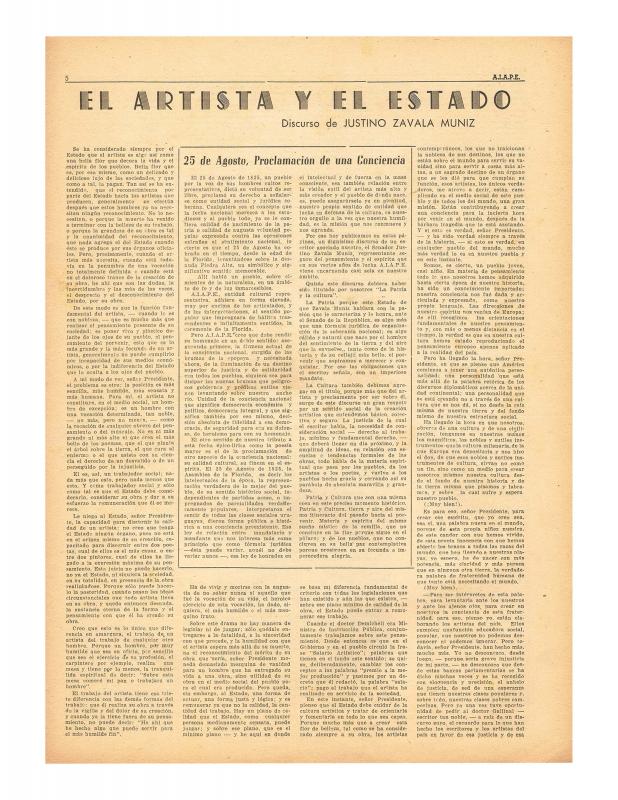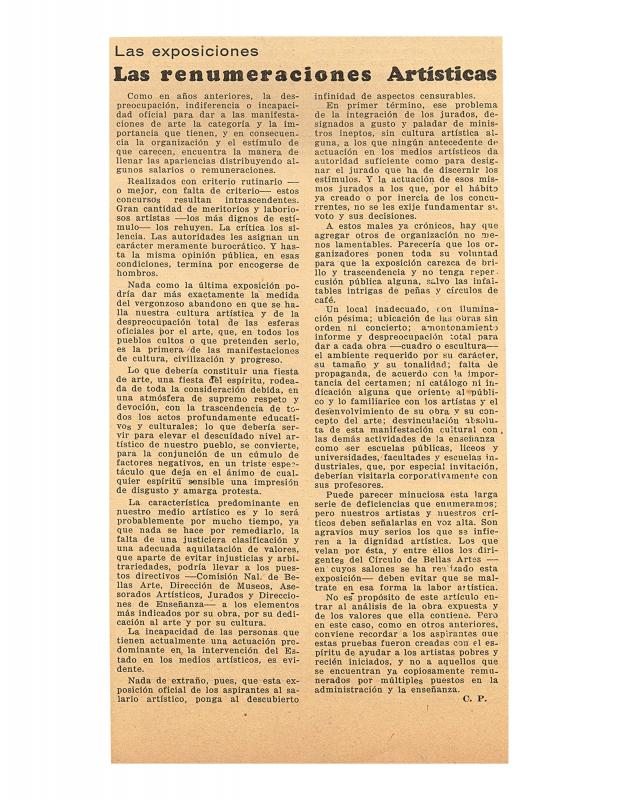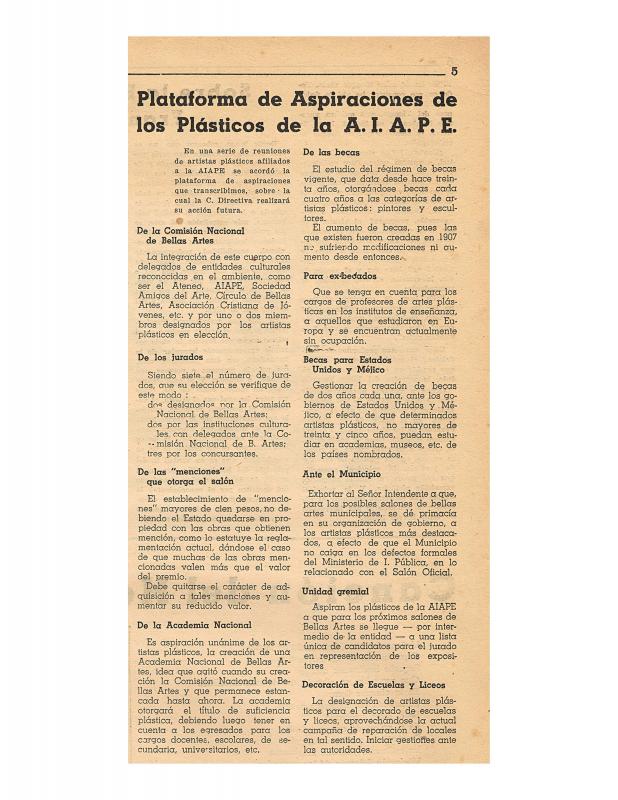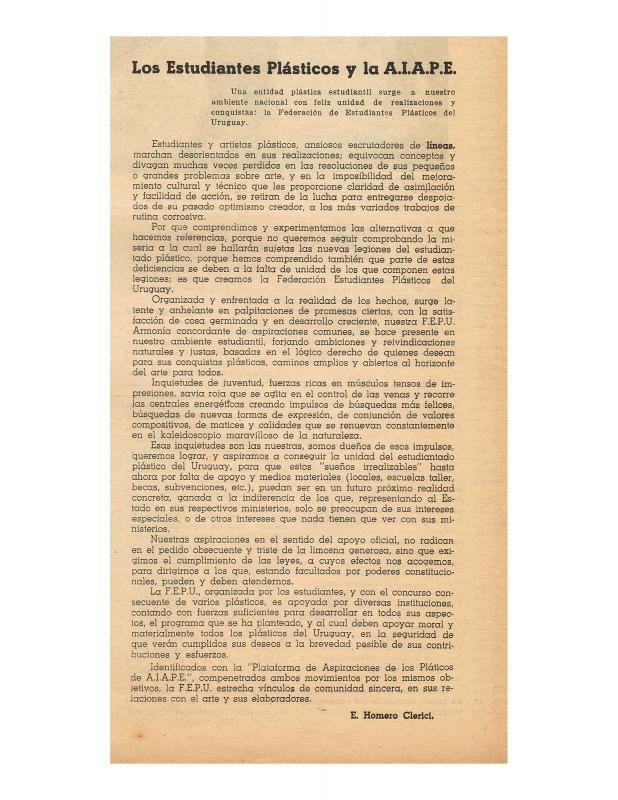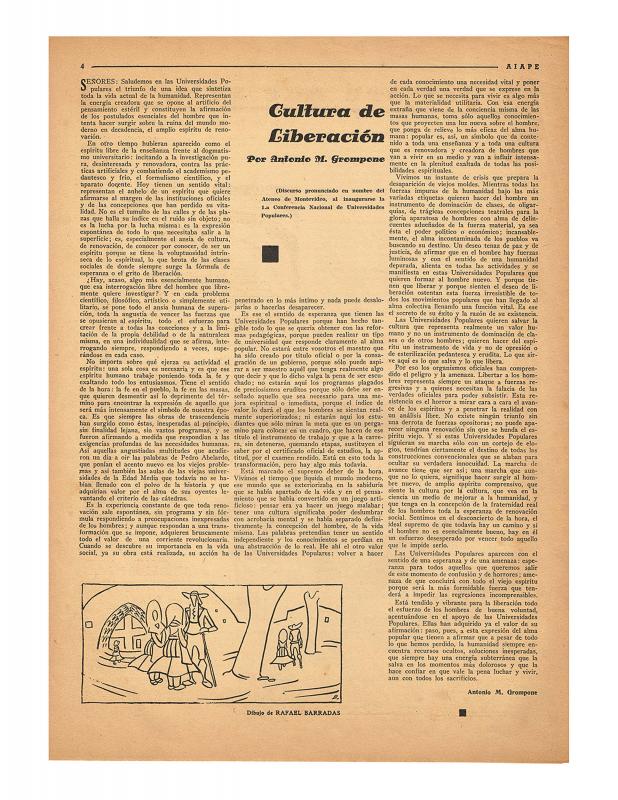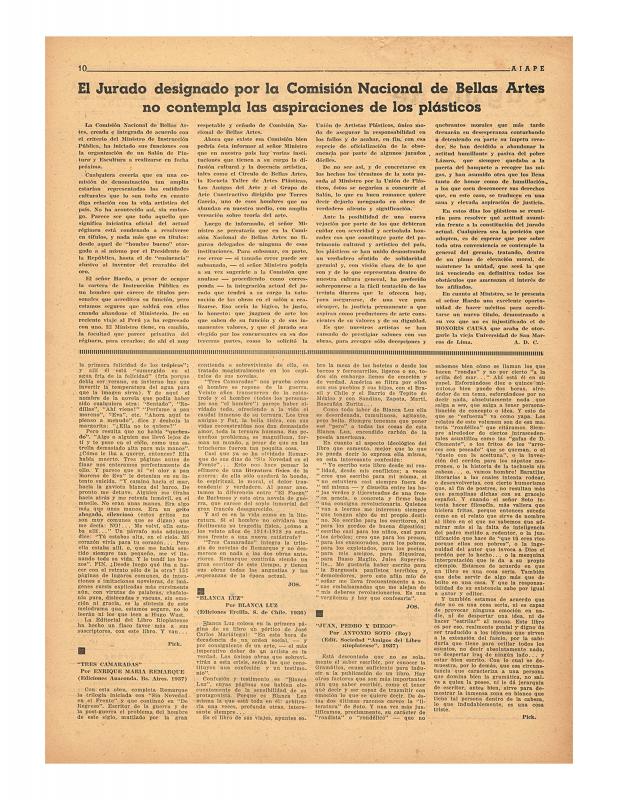Leonidas Spatakis (1911–77) was an essayist, a critic, and a member of the AIAPE (Agrupación de Intelectuales, Artistas, Periodistas y Escritores). This institution was created in 1936 as an offshoot of other anti-fascist and anti-government groups to which many Uruguayan intellectuals belonged in the 1930s. At that point in time, Uruguay was entering a period of social and political unrest that affected how local artists viewed the so-called “Welfare State” that had been introduced in the 1920s. This essay is important because the author explains just how unhappy the members of the AIAPE were with the approach taken by most of the artists who participated in the VI Salón Nacional. In 1940 the Argentinian critic Jorge Romero Brest (1905–89) gave a lecture in which he described the state of contemporary Uruguayan art as “naive” and “anachronistic” and, going beyond the debatable question of categories, made an interesting attempt to review, under one umbrella, the impossibly diverse range of subjects, techniques, and personal agendas that were usually involved in that type of Salón. At the VI Salón Nacional, according to Spatakis, there was a level of conformism that lacked any kind of innovation, since its overall academic style had fostered works by “reactionary right-wingers” whose subject matter and artistic techniques and processes were solidly rooted in conservative points of view. This critique of the prevailing aesthetic at the early Salones Nacionales echoes criticism of the loyalty shown by participating artists to the authoritarian regime that was imposed on the country after the 1933 coup d’état that installed the dictatorship of Gabriel Terra. [As complementary reading see, in the ICAA digital archive, the following articles published in AIAPE: by Joaquín Torres García, “La exposición. [Amigos de España]” (doc. no. 1191197), “El Arte de Arzádum” (doc. no. 1223148), and “El arte de David Alfaro Siqueiros” (doc. no. 1238628); by Cipriano S. Vitureira, “1er Salón Municipal de Artes Plásticas/Su contenido artístico” (doc. no. 1184568), and “La pintura de Miguel Ángel Pareja” (doc. no. 1223795). See also: by Justino Zavala Muniz, “El artista y el Estado” (doc. no. 1216580); “Arte simple,” by Atahualpa del Cioppo (doc. no. 1223119); by Carmelo de Arzadum, “Las artes plásticas de 1936 a 1939” (doc. no. 1224706), and “Urruchúa (doc. no. 1224405); by Roberto Ibáñez (editor in chief), “Demetrio Urruchúa con Nosotros” (doc. no. 1223661), “Las exposiciones. Las remuneraciones artísticas” (doc. no. 1225449), “Los jurados del próximo Salón Nacional de Bellas Artes” (doc. no. 1225548), “Michelena- Escultor” (doc. no. 1223386), and “Plataforma de aspiraciones de los plásticos de la A.I.A.P.E.” (doc. no. 1225398); by Homero Clerici, “Los estudiantes plásticos y la AIAPE [Agrupación de Intelectuales, Artistas, Periodistas, and Escritores]” (doc. no. 1225286); by Felipe Novoa “El grabador Carlos González” (doc. no. 1223870); by Gisleno Aguirre, “La nueva Asociación de Artistas Plásticos” (doc. no. 1225166); by Orestes Baroffio, “Objeto y Significación de Un Salón de Arte” (doc. no. 1210990); and by C.L., “Teseo: los problemas del arte” (doc. no. 1223765). There are also many anonymous articles that were published in AIAPE: “Temas de discusión sobre la cultura Americana” (doc. no. 1225812); “La actividad plástica del año” (doc. no. 1223617); “Alianza de intelectuales, artistas y escritores bolivianos” (doc. no. 1225763); “El arte mejicano” (doc. no. 1225519); “Bases A.I.A.P.E (Agrupación de Intelectuales, Artistas, Periodistas y Escritores)” (doc. no. 1226697); “Cae decorado de Berni bajo la piqueta del G.O.U” (doc. no. 1225213); “Cultura de liberación” (doc. no. 1226424); “Cultura en el orden internacional” (doc. no. 1223996); “La ética social del artista,” unformatted (doc. no. 1223962); “La exposición del Subte a beneficio de Chile,” unformatted (doc. no. 1225245); “Fuera del Salón Oficial” (doc. no. 1221528); “El jurado designado por la Comisión Nacional de Bellas Artes no contempla las aspiraciones de los plásticos” (doc. no. 1225373); “Los jurados de los salarios artísticos de 1935 atentó contra la cultura” (doc. no. 1225596); “La libertad en Portinari” (doc. no. 1225346); “El mensaje de Antonio Berni” (doc. no. 1223596); “Notas editoriales e informativas” (doc. no. 1226398); “Noticia de David Alfaro Siqueiros” (doc. no. 1223640); “Optimismo sobre España” (doc. no. 1225185); “Página de crítica y polémica. Las exposiciones” (doc. no. 1221503); “La pintura en el V Salón de Otoño” (doc. no. 1225672); “Reconocimiento a Élie Faure” (doc. no. 1223458); “VIII Salón Nacional de Bellas Artes” (doc. no. 1211227); and “Sobre la querella del realismo” (doc. no. 1225636)].






